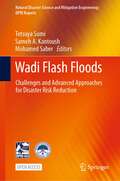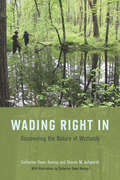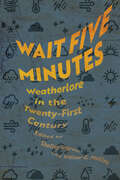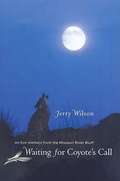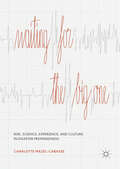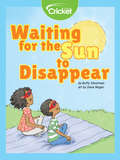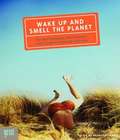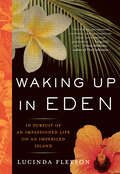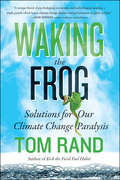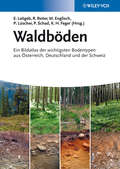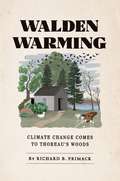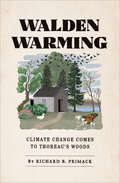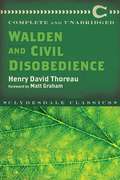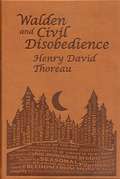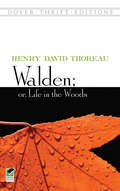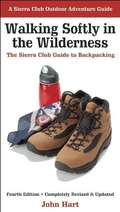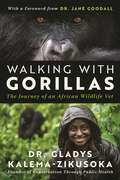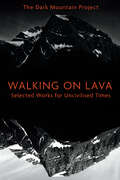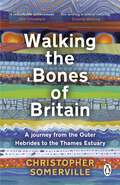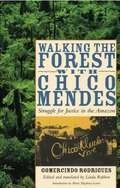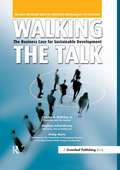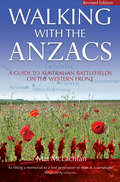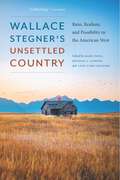- Table View
- List View
Wadi Flash Floods: Challenges and Advanced Approaches for Disaster Risk Reduction (Natural Disaster Science and Mitigation Engineering: DPRI reports)
by Tetsuya Sumi Sameh A. Kantoush Mohamed SaberThis open access book brings together research studies, developments, and application-related flash flood topics on wadi systems in arid regions. The major merit of this comprehensive book is its focus on research and technical papers as well as case study applications in different regions worldwide that cover many topics and answer several scientific questions. The book chapters comprehensively and significantly highlight different scientific research disciplines related to wadi flash floods, including climatology, hydrological models, new monitoring techniques, remote sensing techniques, field investigations, international collaboration projects, risk assessment and mitigation, sedimentation and sediment transport, and groundwater quality and quantity assessment and management. In this book, the contributing authors (engineers, researchers, and professionals) introduce their recent scientific findings to develop suitable, applicable, and innovative tools for forecasting, mitigation, and water management as well as society development under seven main research themes as follows: Part 1. Wadi Flash Flood Challenges and Strategies Part 2. Hydrometeorology and Climate Changes Part 3. Rainfall–Runoff Modeling and Approaches Part 4. Disaster Risk Reduction and Mitigation Part 5. Reservoir Sedimentation and Sediment Yield Part 6. Groundwater Management Part 7. Application and Case Studies The book includes selected high-quality papers from five series of the International Symposium on Flash Floods in Wadi Systems (ISFF) that were held in 2015, 2016, 2017, 2018, and 2020 in Japan, Egypt, Oman, Morocco, and Japan, respectively. These collections of chapters could provide valuable guidance and scientific content not only for academics, researchers, and students but also for decision-makers in the MENA region and worldwide.
Wading Right In: Discovering the Nature of Wetlands
by Catherine Owen Koning Sharon M. AshworthWhere can you find mosses that change landscapes, salamanders with algae in their skin, and carnivorous plants containing whole ecosystems in their furled leaves? Where can you find swamp-trompers, wildlife watchers, marsh managers, and mud-mad scientists? In wetlands, those complex habitats that play such vital ecological roles. In Wading Right In, Catherine Owen Koning and Sharon M. Ashworth take us on a journey into wetlands through stories from the people who wade in the muck. Traveling alongside scientists, explorers, and kids with waders and nets, the authors uncover the inextricably entwined relationships between the water flows, natural chemistry, soils, flora, and fauna of our floodplain forests, fens, bogs, marshes, and mires. Tales of mighty efforts to protect rare orchids, restore salt marshes, and preserve sedge meadows become portals through which we visit major wetland types and discover their secrets, while also learning critical ecological lessons. The United States still loses wetlands at a rate of 13,800 acres per year. Such loss diminishes the water quality of our rivers and lakes, depletes our capacity for flood control, reduces our ability to mitigate climate change, and further impoverishes our biodiversity. Koning and Ashworth’s stories captivate the imagination and inspire the emotional and intellectual connections we need to commit to protecting these magical and mysterious places.
Wait Five Minutes: Weatherlore in the Twenty-First Century
by Shelley Ingram, Willow G. MullinsContributions by Emma Frances Bloomfield, Sheila Bock, Kristen Bradley, Hannah Chapple, James Deutsch, Máirt Hanley, Christine Hoffmann, Kate Parker Horigan, Shelley Ingram, John Laudun, Jordan Lovejoy, Lena Marander-Eklund, Jennifer Morrison, Willow G. Mullins, Anne Pryor, Todd Richardson, and Claire Schmidt The weather governs our lives. It fills gaps in conversations, determines our dress, and influences our architecture. No matter how much our lives may have moved indoors, no matter how much we may rely on technology, we still monitor the weather. Wait Five Minutes: Weatherlore in the Twenty-First Century draws from folkloric, literary, and scientific theory to offer up new ways of thinking about this most ancient of phenomena.Weatherlore is a concept that describes the folk beliefs and traditions about the weather that are passed down casually among groups of people. Weatherlore can be predictive, such as the belief that more black than brown fuzz on a woolly bear caterpillar signals a harsh winter. It can be the familiar commentary that eases daily social interactions, such as asking, “Is it hot (or cold) enough for you?” Other times, it is simply ubiquitous: “If you don’t like the weather, wait five minutes and it will change.” From detailing personal experiences at picnics and suburban lawns to critically analyzing storm stories, novels, and flood legends, contributors offer engaging multidisciplinary perspectives on weatherlore. As we move further into the twenty-first century, an increasing awareness of climate change and its impacts on daily life calls for a folkloristic reckoning with the weather and a rising need to examine vernacular understandings of weather and climate. Weatherlore helps us understand and shape global political conversations about climate change and biopolitics at the same time that it influences individual, group, and regional lives and identities. We use weather, and thus its folklore, to make meaning of ourselves, our groups, and, quite literally, our world.
Waiting for Coyote's Call: An Eco-memoir from the Missouri River Bluff
by Jerry WilsonInspired by the works of Henry David Thoreau, Aldo Leopold, and Annie Dillard, Jerry Wilson's eco-memoir Waiting for Coyote's Call covers twenty-five years of trying to live life while leaving as small an environmental footprint as possible. Wilson encourages the reader to think about his or her place in nature as he recounts his own family's experiences on prairie and woodland near the Missouri River in eastern South Dakota. Wilson chronicles his family's building of an eco-friendly solar home and their attempts to restore the plowed-under prairie to its original state. He muses on the beauty and simplicity of nature in contrast to modern lifestyles in which time is ever-more precious and convenience often outweighs other considerations. Taking the reader on midnight rambles through his "Big Woods," Wilson shares his wonder at the creatures that also make their home on the bluff. From his delight in home-grown tomatoes and high-flying Sandhill cranes to concerns about human interaction with the web of life, the stories of Wilson's quarter of a century on the Missouri River bluff spring off the pages of Waiting for Coyote's Call. Fawns leap and turkeys strut past his window as Wilson listens for the plaintive howl of the prairie predator.
Waiting for the Big One: Risk, Science, Experience, and Culture in Disaster Preparedness
by Charlotte Mazel-CabasseThis book helps understand how the future Big One (a large-scale and often-predicted earthquake) is understood, defined, and mitigated by experts, scientists, and residents in the San Francisco Bay Area. Following the idea that earthquake risk is multiple and hard to grasp, the book explores the earthquake’s “mode of existence,” guiding the reader through different epistemic moments of the earthquake-risk definition. Through in-depth interviews, the book provides a rarely seen anthropology of risk from the perspective of experts, scientists, and concerned residents for whom the possibility of partial or complete destruction of their living environment is a constant companion of their everyday lives. It argues that the characterization of the threats and the measures taken to limit its impacts constitute an integrated part of both their residential experiences and their professional practices.
Waiting for the Sun to Disappear
by Buffy SilvermanJeff and his cousin Liz are waiting to see the solar eclipse! Together, they learn about why eclipses happen and why seeing one is special. Do you know why eclipses happen? Learn how the moon and sun interact with Earth in order to create this solar spectacular!
Wake Up And Smell The Planet: The Non-Pompous, Non-Preachy Grist Guide To Greening Your Day
by Brangien Davis Katharine WrothBased on the Grist website (www. grist. org), this compact guide to making environmentally-responsible choices on a daily basis is an irreverent complement to Al Gore's PowerPoint approach. Davis (a writer/editor in Seattle) and Wroth (an environmental writer) discuss sustainable alternatives to everything from autos to dog, diaper, and electronic waste.
Waking Up in Eden: In Pursuit of an Impassioned Life on an Imperiled Island
by Lucinda FleesonA woman journeys to Kauai to save Hawaii’s native plants: “Part history, part personal confession, part cautionary tale about environmental preservation” (Gioia Diliberto, author of Paris Without End). One day, Lucinda Fleeson quit her big-city newspaper job, sold her suburban house, and moved halfway across the world to the island of Kauai to work at the National Tropical Botanical Garden. Imagine a hundred-acre garden estate nestled amid ocean cliffs, rain forests, and secluded coves. Exotic and beautiful, yes, but as Fleeson awakens to this sensual world, exploring the island’s food, beaches, and history, she encounters an endangered paradise—the Hawaii we don’t see in the tourist brochures. Native plants are dying at an astonishing rate—Hawaii is called the Extinction Capital of the World—and invasive species (plants, animals, and humans) have imperiled this Garden of Eden. Fleeson accompanies a plant hunter into the rain forest to find the last of a dying species, descends into limestone caves with a paleontologist who deconstructs island history through fossil life, and shadows a botanical pioneer who propagates rare seeds, hoping to reclaim the landscape. Her grown-up adventure is a reminder of the value of choosing passion over security, individuality over convention, and the pressing need to protect the earth. And as she witnesses the island’s plant renewal efforts, she sees her own life blossom again. “[An] impeccably researched, beautifully told tale of how America’s most exotic locale transformed the life of an urban journalist.” —Gioia Diliberto “As she delves deep into the island’s history and ventures far into its delicate ecosystem, Fleeson undertakes her own personal and professional salvation, a spirited and daring pilgrimage that is both revelatory and enlightening.” —Booklist
Waking the Frog: Solutions for Our Climate Change Paralysis
by Tom Rand<p>A venture capitalist, entrepreneur, and engineer, Tom Rand looks to contemporary psychology, economics, business, and finance to explain our difficulty in confronting one of the most fundamental problems of our time. Rand’s account doesn’t just point fingers at the bad guys, but goes deeper—to our motivations, institutional lethargy, and deeply buried assumptions about market economics. <p>Waking the Frog reveals that our ingenuity, technology, capital, and policy can work together to turn down the heat—and at the same time enable the largest economic opportunity of the twenty-first century. </p>
Waldböden: Ein Bildatlas der Wichtigsten Bodentypen aus Österreich, Deutschland und der Schweiz
by Ernst Leitgeb Rainer Reiter Michael Englisch Peter Lüscher Peter Schad Karl Heinz FegerEin einzigartiger Bildband reich an Beispielen der maßgeblichen Bodentypen. Im Fokus: die Waldgebiete Österreichs, Deutschlands und der Schweiz. Zu jedem Bodenprofil sind umfassende Daten zu über 40 Bodenmerkmalen angeführt, die anschaulich aufbereitet und interpretiert sind. Zusammen mit Kommentaren zum Baumwachstum und zur Waldbewirtschaftung liefern diese Bodendokumentationen wertvolle Hinweise für die Praxis. Die zum Teil speziell für dieses Buch aufgenommenen Bodenprofile (Auflagehumus und Mineralboden) sind eine gute Unterstützung für die Bodenansprache vor Ort. Vereinheitlichte bodenkundliche Methoden, die im Erläuterungsteil ausführlich erklärt sind, erlauben einen raschen Vergleich der Böden. Gerade durch die aktuelle Debatte über mögliche Folgen einer Klimaänderung für die Waldwirtschaft und über die Kohlenstoffspeicherung in Wäldern steht der Waldboden im Mittelpunkt des Interesses. Ein kompakter und 'geländetauglicher' Waldboden-Atlas für alle bodenkundlich Interessierten in Lehre, Praxis, Verwaltung, Beratung und Planung.
Walden Warming: Climate Change Comes to Thoreau's Woods
by Richard B. PrimackIn his meticulous notes on the natural history of Concord, Massachusetts, Henry David Thoreau records the first open flowers of highbush blueberry on May 11, 1853. If he were to look for the first blueberry flowers in Concord today, mid-May would be too late. In the 160 years since Thoreau’s writings, warming temperatures have pushed blueberry flowering three weeks earlier, and in 2012, following a winter and spring of record-breaking warmth, blueberries began flowering on April 1--six weeks earlier than in Thoreau’s time. The climate around Thoreau’s beloved Walden Pond is changing, with visible ecological consequences. In Walden Warming, Richard B. Primack uses Thoreau and Walden, icons of the conservation movement, to track the effects of a warming climate on Concord’s plants and animals. Under the attentive eyes of Primack, the notes that Thoreau made years ago are transformed from charming observations into scientific data sets. Primack finds that many wildflower species that Thoreau observed--including familiar groups such as irises, asters, and lilies--have declined in abundance or have disappeared from Concord. Primack also describes how warming temperatures have altered other aspects of Thoreau’s Concord, from the dates when ice departs from Walden Pond in late winter, to the arrival of birds in the spring, to the populations of fish, salamanders, and butterflies that live in the woodlands, river meadows, and ponds. Primack demonstrates that climate change is already here, and it is affecting not just Walden Pond but many other places in Concord and the surrounding region. Although we need to continue pressuring our political leaders to take action, Primack urges us each to heed the advice Thoreau offers in Walden: to "live simply and wisely. ” In the process, we can each minimize our own contributions to our warming climate.
Walden Warming: Climate Change Comes to Thoreau's Woods
by Richard B. Primack&“An unnervingly close-to-home perspective [on] the dynamics and impact of climate change on plants, birds, and myriad other species, including us.&”—Booklist In his meticulous notes on the natural history of Concord, Massachusetts, Henry David Thoreau records the first open flowers of highbush blueberry on May 11, 1853. If he were to look for the first blueberry flowers in Concord today, mid-May would be too late. Warming temperatures have pushed blueberry flowering three weeks earlier, and in 2012, following a period of record-breaking warmth, blueberries began flowering on April 1—six weeks earlier than in Thoreau&’s time. In Walden Warming, Richard B. Primack uses Thoreau and Walden, icons of the conservation movement, to track the effects of a warming climate on Concord&’s plants and animals, with the notes that Thoreau made years ago transformed from charming observations into scientific data sets. Primack finds that many wildflower species that Thoreau observed, including familiar groups such as irises, asters, and lilies, have declined in abundance or disappeared from Concord. Primack also describes how warming temperatures have altered other aspects of Thoreau&’s Concord, from the dates when ice departs from Walden Pond in late winter, to the arrival of birds in the spring, to the populations of fish, salamanders, and butterflies that live in the woodlands, river meadows, and ponds. Demonstrating the effects of climate change in a unique, concrete way using this historical and literary landmark as a touchstone, Richard Primack urges us to heed the advice Thoreau offers in Walden: to live simply and wisely. In the process, we can minimize our own contributions to our warming climate.
Walden and Civil Disobedience (First Avenue Classics Ser.)
by Henry David Thoreau Matt GrahamPackaged in handsome, affordable trade editions, Clydesdale Classics is a new series of essential works. From the musings of academics such as Thomas Paine in Common Sense to the striking personal narrative of Harriet Jacobs in Incidents in the Life of a Slave Girl, this new series is a comprehensive collection of our intellectual history through the words of the exceptional few.First published in 1854, Walden was written by the renowned transcendentalist Henry David Thoreau about his experience living off the land at Walden Pond for more than two years. Thoreau divides his deliberations and meditations into a variety of sections which include his views on economy and the natural world, the importance of reading and literature, the values of both solitude and companionship, and other personal reflections. In addition to Walden, this edition also includes Thoreau’s essay on Civil Disobedience, which discusses his views on the nature of government and its negative effects on society.With a new foreword by survivalist Matt Graham, venture into the woods with Thoreau and explore the complexities of life and truth in this classic piece of American literature.
Walden and Civil Disobedience (Wordsworth Classics)
by Henry David ThoreauThe oft-quoted transcendentalist Henry David Thoreau is best known for two works: Walden and Civil Disobedience. Walden, first published in 1854, documents the time Thoreau spent living with nature in a hand-built cabin in the woods near Walden Pond in Massachusetts. A minor work in its own time, Walden burgeoned in popularity during the counter culture movement of the 1960s. Civil Disobedience is thought to have originated after Thoreau spent a night in jail for refusing to pay taxes to a government with whose policies he did not agree. Assigning greater importance to the conscience of the individual than the governing law, Civil Disobedience is an internationally admired work that is known to have influenced writer Leo Tolstoy and political activist Mahatma Gandhi, and many members of the American Civil Rights Movement. Now available together in one chic and affordable edition as part of the Word Cloud Classics series, Walden and Civil Disobedience makes an attractive addition to any library
Walden; Or, Life in the Woods
by Henry David ThoreauNature was a form of religion for naturalist, essayist, and early environmentalist Henry David Thoreau (1817–62). In communing with the natural world, he wished to "live deliberately, to front only the essential facts of life, and … learn what it had to teach." Toward that end Thoreau built a cabin in the spring of 1845 on the shores of Walden Pond — on land owned by Ralph Waldo Emerson — outside Concord, Massachusetts. There he observed nature, farmed, built fences, surveyed, and wrote in his journal.One product of his two-year sojourn was this book — a great classic of American letters. Interwoven with accounts of Thoreau's daily life (he received visitors and almost daily walked into Concord) are mediations on human existence, society, government, and other topics, expressed with wisdom and beauty of style.Walden offers abundant evidence of Thoreau's ability to begin with observations on a mundane incident or the minutiae of nature and then develop these observations into profound ruminations on the most fundamental human concerns. Credited with influencing Tolstoy, Gandhi, and other thinkers, the volume remains a masterpiece of philosophical reflection.A selection of the Common Core State Standards Initiative.
Walkable City Rules: 101 Steps to Making Better Places
by Jeff Speck"Cities are the future of the human race, and Jeff Speck knows how to make them work.”—David Owen, staff writer at the New YorkerNearly every US city would like to be more walkable—for reasons of health, wealth, and the environment—yet few are taking the proper steps to get there. The goals are often clear, but the path is seldom easy. Jeff Speck's follow-up to his bestselling Walkable City is the resource that cities and citizens need to usher in an era of renewed street life. WalkableCity Rules is a doer's guide to making change in cities, and making it now.The 101 rules are practical yet engaging—worded for arguments at the planning commission, illustrated for clarity, and packed with specifications as well as data. For ease of use, the rules are grouped into 19 chapters that cover everything from selling walkability, to getting the parking right, escaping automobilism, making comfortable spaces and interesting places, and doing it now!Walkable City was written to inspire;Walkable City Rules was written to enable.Itis the most comprehensive tool available for bringing the latest and most effective city-planning practices to bear in your community. The content and presentation make it a force multiplier for place-makers and change-makers everywhere.
Walking Softly in the Wilderness: The Sierra Club Guide to Backpacking (4th edition)
by John HartThe ultimate manual for wilderness travelers and campers, "Walking Softly in the Wilderness" is the groundbreaking guide that first taught backpackers how to enjoy a genuine wilderness experience that leaves nature undisturbed. In recent years backpacking gear and practices have undergone many changes, and all are noted and expertly evaluated by author John Hart in this new edition. Covering the latest in "ultralight" gear choices, as well as down-loadable maps, portable GPS devices, and the world of online information, Hart is a sure-footed guide to this changing scene.
Walking With Gorillas: The Journey of an African Wildlife Vet
by Dr. Gladys Kalema-ZikusokaAn Inspiring Memoir, for Fans of Jane Goodall, Dian Fossey, and Frans De Waal. In her enchanting memoir, Dr. Gladys Kalema-Zikusoka, Uganda&’s first wildlife veterinarian, tells the remarkable story from her animal-loving childhood to her career protecting endangered mountain gorillas and other wild animals. She is also the defender of people as a groundbreaking promoter of human public health and an advocate for revolutionary integrated approaches to saving our planet. In an increasingly interconnected world, animal and human health alike depend on sustainable solutions and Dr. Gladys has developed an innovative approach to conservation among the endangered Mountain Gorillas of Bwindi Impenetrable Forest and their human neighbors.Walking with Gorillas takes the reader on an incredible personal journey with Dr. Gladys, from her early days as a student in Uganda, enduring the assassination of her father during a military coup, to her veterinarian education in England to establishing the first veterinary department for the Ugandan government to founding one of the first organizations in the world that enables people to coexist with wildlife through improving the health and wellbeing of both. Her award-winning approach reduced the impact of the COVID-19 pandemic on critically endangered mountain gorillas. In the face of discrimination and a male dominated world, one woman&’s passion and determination to build a brighter future for the local wildlife and human community offers inspiration and insights into what is truly possible for our planet when we come together.
Walking on Lava: Selected Works for Uncivilised Times
by The Dark Mountain ProjectThe Dark Mountain Project began with a manifesto published in 2009 by two English writers—Dougald Hine and Paul Kingsnorth—who felt that literature was not responding honestly to the crises of our time.In a world in which the climate is being altered by human activities; in which global ecosystems are being destroyed by the advance of industrial civilisation; and in which the dominant economic and cultural assumptions of the West are visibly crumbling, Dark Mountain asked: where are the writers and the artists? Why are the mainstream cultural forms of our society still behaving as if this were the twentieth century—or even the nineteenth?Dark Mountain&’s call for writers, thinkers and artists willing to face the depth of the mess we are in has made it a gathering point for a growing international network. Rooted in place, time and nature, their work finds a home in the pages of the Dark Mountain books, with two new volumes published every year.Walking on Lava brings together the best of the first ten volumes, along with the original manifesto. This collection of essays, fiction, poetry, interviews and artwork introduces The Dark Mountain Project&’s groundbreaking work to a wider audience in search of &‘the hope beyond hope, the paths which lead to the unknown world ahead of us.&’
Walking the Bones of Britain: A 3 Billion Year Journey from the Outer Hebrides to the Thames Estuary
by Christopher Somerville‘Somerville’s infectious enthusiasm and wry humour infuse his journey from the Isle of Lewis to southern England, revealing our rich geological history with vibrant local and natural history’ Observer‘A meticulous exploration of the ground beneath our feet. Glorious’ Katharine Norbury‘A remarkable achievement’ Tom Chesshyre‘His writing is utterly enticing’ Country Walking...............................................................................................................................................The influence Britain’s geology has had on our daily lives is profound. While we may be unaware of it, every aspect of our history has been affected by events that happened ten thousand, a million, or a thousand million years ago.In Walking the Bones of Britain, Christopher Somerville takes a journey of a thousand miles, beginning in the far north, at the three-billion-year-old rocks of the Isle of Lewis, formed when the world was still molten, and travelling south-eastwards to the furthest corner of Essex, where new land is being formed. Crossing bogs, scaling peaks and skirting quarry pits, he unearths the stories bound up in the layers of rock beneath our feet, and examines how they have influenced everything from how we farm to how we build our houses, from the Industrial Revolution to the current climate crisis.Told with characteristic humour and insight, this gripping exploration of the British landscape and its remarkable history cannot fail to change the way you see the world beyond your door.‘Somerville is a walker’s writer’ Nicholas Crane
Walking the Forest with Chico Mendes: Struggle for Justice in the Amazon
by Gomercindo RodriguesA close associate of Chico Mendes, Gomercindo Rodrigues witnessed the struggle between Brazil's rubber tappers and local ranchers--a struggle that led to the murder of Mendes. Rodrigues's memoir of his years with Mendes has never before been translated into English from the Portuguese. Now, Walking the Forest with Chico Mendes makes this important work available to new audiences, capturing the events and trends that shaped the lives of both men and the fragile system of public security and justice within which they lived and worked. In a rare primary account of the celebrated labor organizer, Rodrigues chronicles Mendes's innovative proposals as the Amazon faced wholesale deforestation. As a labor unionist and an environmentalist, Mendes believed that rain forests could be preserved without ruining the lives of workers, and that destroying forests to make way for cattle pastures threatened humanity in the long run. Walking the Forest with Chico Mendes also brings to light the unexplained and uninvestigated events surrounding Mendes's murder. Although many historians have written about the plantation systems of nineteenth-century Brazil, few eyewitnesses have captured the rich rural history of the twentieth century with such an intricate knowledge of history and folklore as Rodrigues.
Walking the Talk: The Business Case for Sustainable Development
by Philip Watts Jr, Charles Holliday Stephan SchmidheinyThe authors argue the business case for sustainable development in this study that explores a range of issues beginning with corporate social responsibility and ending with eco-efficiency.
Walking with the ANZACS: The authoritative guide to the Australian battlefields of the Western Front
by Mat McLachlan'[Mat McLachlan's] knowledge of the front is comprehensive' - Sydney Morning HeraldA complete guide to the Australian battlefields of the Western Front 1916-18.Walking with the ANZACs aims to become the new essential companion for Australians visiting the Western Front. Each of the 14 most important Australian battlefields is covered with descriptions of the battles and Australia?s involvement in it.The book presents a well-illustrated walking tour across the old battlefields. The tours are designed along easily accessible walking routes and show readers battlefield landmarks that still exist, memorials to the men who fought there and the cemeteries where many of them still lie. In this way the visitor will see the battlefield in much the same way as the original ANZACs did, and gain a greater appreciation of the site?s significance. Importantly, the tours are not written for military experts, but for ordinary visitors whose military knowledge may be limited.More than just a handy travel guide, Walking with the ANZACs is an absorbing read for armchair travellers and students of the First World War who may not have had the opportunity to visit the battle fields and walk in the footsteps of the first ANZACs.
Wallace Stegner's Unsettled Country: Ruin, Realism, and Possibility in the American West
by Michael J. Lansing Mark Fiege Leisl Carr ChildersWallace Stegner is an iconic western writer. His works of fiction, including the Pulitzer Prize–winning Angle of Repose and Big Rock Candy Mountain, as well as his nonfiction books and essays introduced the beauty and character of the American West to thousands of readers. Wallace Stegner&’s Unsettled Country assesses his life, work, and legacy in light of contemporary issues and crises. Along with Stegner&’s achievements, the contributors show how his failures offer equally crucial ways to assess the past, present, and future of the region. Drawing from history, literature, philosophy, law, geography, and park management, the contributors consider Stegner&’s racial liberalism and regional vision, his gendered view of the world, his understandings of conservation and the environment, his personal experience of economic collapse and poverty, his yearning for community, and his abiding attachment to the West. Wallace Stegner&’s Unsettled Country is an even-handed reclamation of Stegner&’s enduring relevance to anyone concerned about the American West&’s uncertain future.
Walleye: A Beautiful Fish of the Dark
by Paul J. RadomskiWalleye, the holy grail of game fish: on catching them, understanding their biology and history, and ensuring their survival Among the more than 34,000 species of fish, few have the walleye&’s following—among anglers and diners, states conferring official status on the fish, and towns battling for recognition as the Walleye Capital of the World. And among those passionate fans, few know the walleye as well as Paul J. Radomski does—a fisheries biologist, lake ecology scientist, and old fisherman. In Walleye: A Beautiful Fish of the Dark he unspools the mysteries of this fascinating fish.Radomski looks at walleye from every angle, with something to say to the curious naturalist, committed ecologist, and avid fishing enthusiast. People who view walleye as the &“lion of the lakes&” might be surprised to learn that rivers are their ancestral habitat. Some might wonder about the name &“wall-eye,&” a nod to an evolutionary adaptation to dark water environments. Others might simply ask: why walleye? What are they, where do they exist, how do they survive, and how have people come to depend on them? Radomski discusses the principles and pitfalls of managing this predator of the twilight (and the history and methods of doing so) and shares his informed perspective on when and where stocking is prudent. Finally, he explores three of the best walleye lakes: Winnebago, the largest inland walleye fishery in Wisconsin, and Mille Lacs and Red Lake in Minnesota.From the simple pleasures of fishing for walleye to the most pressing questions about how this species survives, this book is the best word on this beautiful fish of the dark.
